
Global Untargeted Metabolomics Plus
PANOMIX developed the Global Untargeted Metabolomics Plus detection technology independently, with independent intellectual property rights, is a new generation technology based on conventional untargeted metabolomics. It is characterized by high-throughput, semi-quantitative and full-substance annotation, and is used to investigate the qualitative and quantitative changes of all small molecule metabolites in samples such as body fluids, cells and tissues after stimulation or perturbation of biological systems.
PANOMIX Global Untargeted Metabolomics Plus technology has applied for a patent
Untargeted metabonomics collects as much substance information as possible, obtains the metabolite through the data processing and the database search match, as the new generation of untragented metabonomics, the global untragented metabonomics is innovatively optimized in experiment and data analysis: the relative concentrations of metabolites in metabonomics samples were calculated using both isotope internal standard and mixed QC (mixed standard sample) as calibration substance, the differential metabolites of primary variables were obtained by MS analysis, and the complete identification form of metabolites was obtained by MS/MS analysis, especially the differential metabolites with clear components or structures.
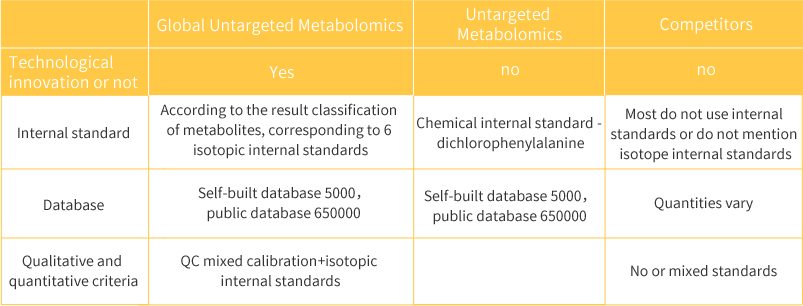
Global untargeted metabolomics has been innovatively optimized in the experimental link and data analysis link: different from the previous research mode, there is no need to extract multiple reaction monitoring mode (MRM) transitions from high-resolution mass spectrometry data, and then transfer to triple quadrupole mass spectrometry. Quantitative scans of these transitions are performed, but the mass spectral primary variable information is first extracted directly from the high-resolution mass spectrometry data, and the isotopic internal standard and mixed QC (mixed standard) are used as calibration substances to calculate the metabolism in metabolomics samples. (The relative concentration of the substance). The global untragented metabonomics does not need to use two mass spectrometry platforms (quadrupole mass spectrometry and high-resolution mass spectrometry) at the same time, and only one (high-resolution mass spectrometry) can meet the dual requirements of qualitative and quantitative, with low cost, simple operation and wide applicability.
1)Q Exactive™ mass spectrum platform, more accurate and more stable
The mass spectrometer uses Thermo Scientific™ Q Exactive™ mass spectrometer, combined quadrupole Orbitrap mass spectrometer provides sensitivity, selectivity, flexibility, and usability for the screening, quantification, identification, and identification of target and untarget compounds, and it can be more accurately and efficiently qualitative and quantitative. PANOMIX is a CMA certified company, and Thermo Scientific™ Q Exactive™ mass spectrometer is 3Q certified. The machine uses the positive and negative ion mode to separate the sample into the way to ensure no loss of substances to the greatest extent.
2)Double scale, strict quantification
According to the structural classification of metabolites, matching 6 isotope Internal standard, stable isotope internal standard (SIL-IS) can improve the robustness of mass spectrometry data, which is superior to chemical internal standard, it can detect the extraction efficiency of each sample and eliminate the error caused by the extraction efficiency. The chromatographic separation and mass spectrum detection of SIL-IS in QC sample are stable and can be reproduced. The different concentration gradient standard curve (each substance has a standard curve) is prepared based on mixed QC, which can be used for precise quantitative analysis of data.
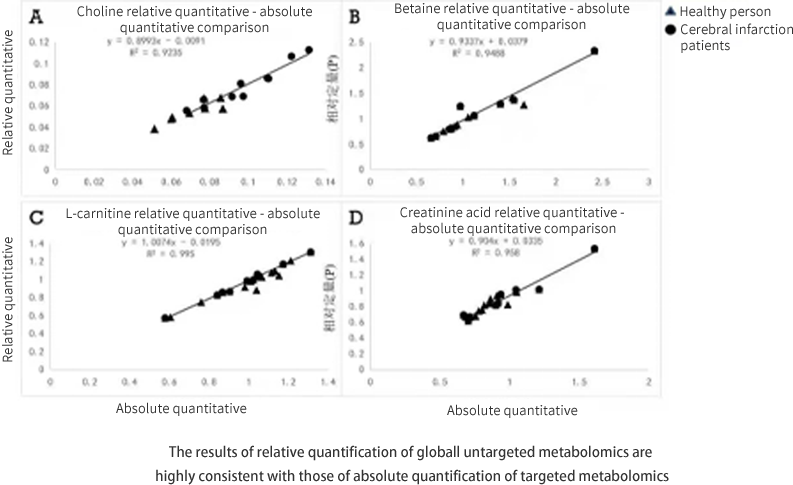
3)The algorithm is more accurate and reduces false positives
Strict data quality control and algorithm optimization based on stable isotope internal standard and hybrid QC improve the accuracy of untargeted metabonomics orientation and quantitative results. For example: RSD < 30% ; if the gradient of the mixture QC is linear or not; at the same time, the matching degree is more than 85% , to ensure the authenticity of identified substances. The number of annotated substances can reach more than 1,500 kinds, which is more accurate than conventional untargets metabonomics, to better target the metabolites.
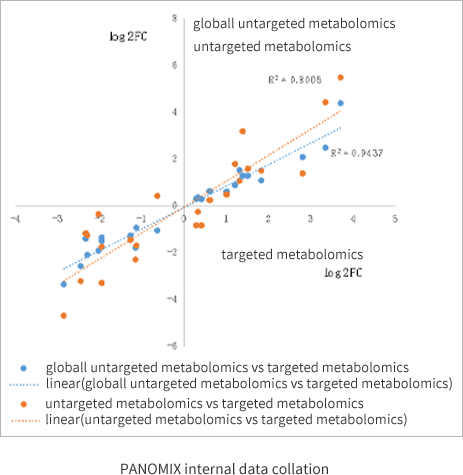
4)Complete data integration, Unbiased detection
The qualitative and quantitative analysis of metabolites is based on PANOMIX self-built database and public database, which can not only detect known metabolites, but also predict unknown metabolites. We are the first comprise to provide a variety of authoritative database annotation, comprehensive analysis of detected substances, a powerful self-built database of BioDeep 5000 + , a combination of MoNA, METLIN, HMDB, LipidSearch and other databases, the total number of substances 650,000 + , realized the ultra-high-volume substances of identification
 Association chord diagram
Association chord diagram Statistical histogram of differential metabolites
Statistical histogram of differential metabolites Classification map of metabolites with full identification
Classification map of metabolites with full identification  Association network diagram of metabolic pathways
Association network diagram of metabolic pathways Differential metabolite heat map
Differential metabolite heat map  Differential metabolite association heat-map
Differential metabolite association heat-mapJournal: Science of The Total Environment(IF=7.961) Published date:2020
Ammonia and thermal stress frequently have harmful effects on aquatic animals. The intestine is an important barrier allowing the body to defend against stress. In this study, we investigated the intestinal microbiota and transcriptomic and metabolomic responses of Litopenaeus vannamei subjected to individual and combined ammonia and thermal stress. The results showed that obvious variation in the intestinal microbiota was observed after stress exposure, with increased levels of Firmicutes and decreased levels of Bacteroidetes and Planctomycetes. Several genera of putatively beneficial bacteria (Demequina, Weissella and Bacteroides) were abundant, while Formosa, Kriegella, Ruegeria, Rhodopirellula and Lutimonas were decreased; pathogenic bacteria of the genus Vibrio were increased under individual stress but decreased under combined stress. The intestinal transcriptome revealed several immune-related differentially expressed genes associated with the peritrophic membrane and antimicrobial processes in contrasting accessions. Haemolymph metabolomic analysis showed that stress exposure disturbed the metabolic processes of the shrimp, especially amino acid metabolism. This study provides insight into the underlying mechanisms associated with the intestinal microbiota, immunity and metabolism of L. vannamei in response to ammonia and thermal stress; ten stress-related metabolite markers were identified, including L-lactic acid, gulonic acid, docosahexaenoic acid, L-lysine, gamma-aminobutyric acid, methylmalonic acid, trans-cinnamate, N-acetylserotonin, adenine, and dihydrouracil.

1.Ammonia-heat stress changed the microbiome of Litopenaeus Vannamei, among which proteobacteria, bacteroidetes and firmicutes were the dominant intestinal bacteria. The variation of Proteus abundance showed that ammonia-heat stress had different effects on Proteus homeostasis, and heat stress might reduce the contribution of Proteus to host metabolism and digestion, and compound stress induces their function. The higher abundance of sclerenchyma and lower abundance of bacteroidetes showed that ammonia-heat stress affected the metabolic ability of enterobacteria of Litopenaeus Vannamei.
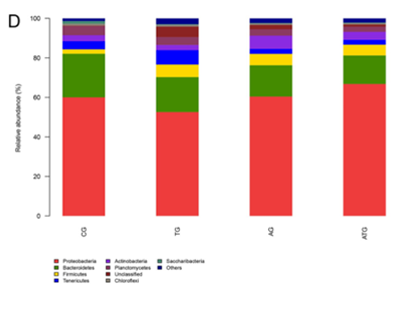 Average relative abundance of dominant bacterial phyla
Average relative abundance of dominant bacterial phyla
2.In this study, we used RNA-Seq technology to analyse the effect of ammonia and thermal stress on the intestinal transcriptome in L. vannamei. Based on the analysis of KEGG pathways, the individual and combined ammonia and thermal stress had different effects on gene expression in the intestine
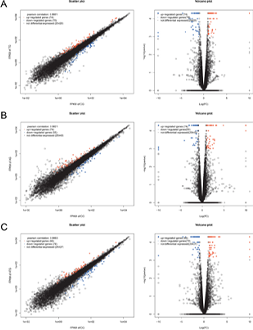 Scatter and volcano plots of intestinal tract after ammonia and temperature stress
Scatter and volcano plots of intestinal tract after ammonia and temperature stress
 The most enriched GO terms and pathways of the DEGs in the intestine of L. vannamei after ammonia and thermal stress
The most enriched GO terms and pathways of the DEGs in the intestine of L. vannamei after ammonia and thermal stress
3. Hemolymph metabolomics analysis proved that ammonia-heat stress affected the metabolic function of Litopenaeus vannamei, especially amino acid metabolism. The decrease of VB6 level further confirmed that ammonia-heat stress caused the disorder of amino acid metabolism. Abnormal hemolymph metabolism, 9 metabolic markers were identified, including lactate, gulonic acid, docosahexaenoic acid, lysine, aminobutyric acid, methylmalonic acid, cinnamic acid, N-acetyl Serotonin and dihydrouracil.
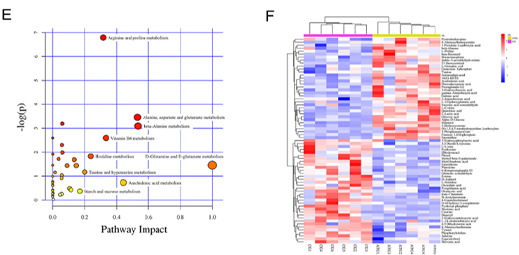 KEGG pathway and hierarchical cluster analysis of hemolymph enrichment after ammonia and heat stress in Litopenaeus vannamei
KEGG pathway and hierarchical cluster analysis of hemolymph enrichment after ammonia and heat stress in Litopenaeus vannamei
4. In the correlation between intestinal bacteria and host immune DEGs, the reduction of Maribacter, Formosa, Kriegella, Muricauda and Lutimonas was positively correlated with shrimp intestinal immune-related genes (PT-1, PPAE-2α and MBP), revealing that these bacteria may Immunity and tricarboxylic acid cycle of Litopenaeus vannamei were affected. As a starch-degrading bacteria, the elevated levels of Demequina were positively correlated with the changes of immune-related genes (PT-1, PPAE-2α and MBP) and glycolytic metabolites, indicating that Demequina is involved in the ammonia-heat of L. vannamei Stress immune response and glycolysis.
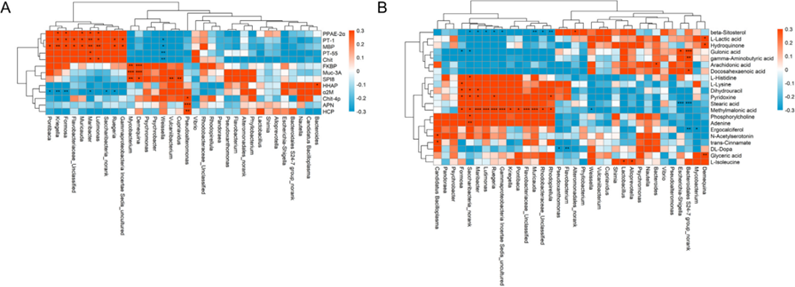 Intestinal bacteria were significantly correlated with DEGs and DEMs at genus level
Intestinal bacteria were significantly correlated with DEGs and DEMs at genus level
5. Decreased levels of adenosine and uracil suggest that these stresses affect the production of energy and nucleic acid species, thus, ammonia-heat stress, alone and in combination, disrupts shrimp metabolic homeostasis.
We investigated the toxic effects of ammonia and thermal stress on L. vannamei using integrated analysis of the microbiome, transcriptome and metabolome. Ammonia and thermal stress caused variations in the intestinal bacterial community, with an increase in Firmicutes and a decrease in Bacteroidetes. The abundance of some beneficial substanceproducing bacteria decreased, Under single stress, the number of vibrios increased, but under combined stress, the number of vibrios decreased. The results of intestinal transcription group showed that immune-related genes were related to peritrophic membrane and antimicrobial process. In the correlation between intestinal bacteria and host metabolites, Demequina was positively correlated with the changes of glycerol and l-lactic acid. Bacteroides were positively correlated with the changes of arachidonic acid, while Lutiomonas, Muricauda, Rhodopirula, and Ruegeria were positively correlated with the changes of Methylmalonic Acid, and negatively correlated with the changes of sitosterol. Several highly related bacteria, genes and metabolites selected in this study can be used as biomarkers for ammonia-heat stress response.
This study revealed the intestinal microflora, immune and metabolic mechanism of Litopenaeus Vannamei under ammonia-heat stress, and identified 9 metabolic markers related to stress. Several intestinal bacterial genera had significant correlations with host genes and metabolic markers, but their mechanisms still need to be explored
Duan Y , D Xiong, Wang Y , et al. Toxic effects of ammonia and thermal stress on the intestinal microbiota and transcriptomic and metabolomic responses of Litopenaeus vannamei[J]. Science of The Total Environment, 2020, 754:141867.
 © Copyright 2015-2022 Suzhou PANOMIX Biomedical Tech Co.,Ltd
© Copyright 2015-2022 Suzhou PANOMIX Biomedical Tech Co.,Ltd